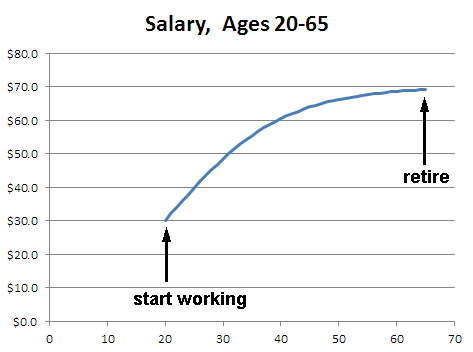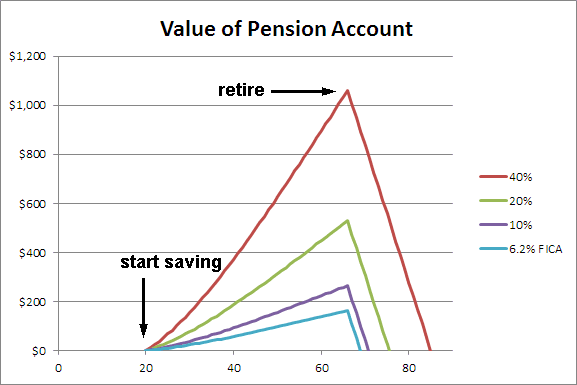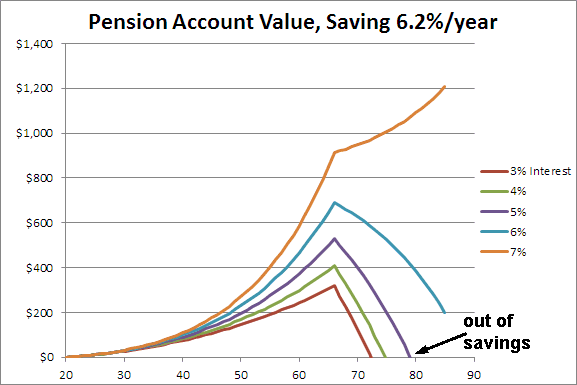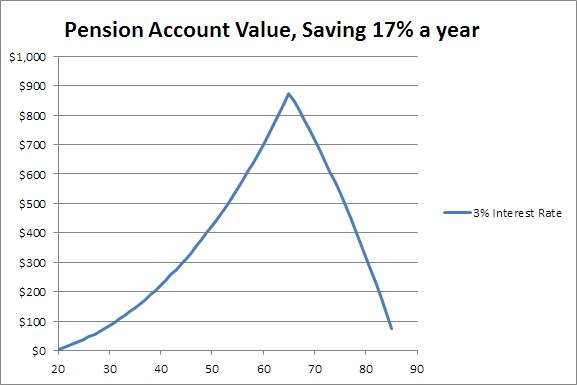| g e n u i n e i d e a s | ||||||
 |
 |
 |
 |
 |
 |
 |
| home | art and science |
writings | biography | food | inventions | search |
| pondering pensions | ||||
|
From Morningstar Perspectives December 2010 Thinking of retiring on Social Security? Or on a company pension? Or by tapping into your 401K? Think again. And don't blame the usual suspects. Blame GDP. Gross Domestic Product? What does GDP have to do with my retirement pension income? Well, hardly anyone can retire on savings alone. To make ends meet, you have to rely on supplemental income from bank interest or stock appreciation. And in the future, GDP growth will limit pension returns. Here's why: Assume you started working at age 20, and retired at age 65, with your salary rising from $30k/year to $70k/year (for the moment we're ignoring taxes and assuming all numbers are inflation adjusted). Here's what your salary might look like over time:
Now let's also assume you plan on living off 80% of your final year's salary in retirement, or around $56k/year. Thanks to safe drinking water, sanitary living conditions, vaccines and ample food supplies, we've almost doubled life expectancy since the early 1900's. So you will survive to a ripe 85, and enjoy 20 years of retirement. Now imagine building a nest egg in your own pension account. No social security in this model- you're self-funding. And no interest either, the money's stuffed into the mattress. The next chart illustrates how that pile of cash grows from age 20 to 65, and how it declines as you withdraw those pension assets to live on (at $56k/year). Of course, the goal is to not run out of money before you die. Note you must save an amazing (and impractical) 40% a year to safely reach age 85!
Amazing perhaps, but not surprising. You're only working 45/65 years of your adult life, or roughly 70% of the time. Given lower earning power when young, simple math determines a 40% savings rate is the minimum barrier to retirement. How likely are you to achieve a million dollars in financial savings, when the median retired household net worth (not including your house, but including IRAs) is under $250K? Not very. So now you appreciate why our great-grandparents worked until their last day on earth. They had no other choice.
Ah, you say. Not only am I saving a bit every year, but I've also INVESTED those funds, earning interest, receiving dividends and gaining stock appreciation. Much of that investment will be in the stock market, and historically stock market returns, averaged over the decades, are claimed to generate around an 8%/year effective return. For this very reason, most pension funds assume they are financially sound when plugging an 8% return into their calculations. Compound interest makes a huge difference. The next graph demonstrates how saving a more realistic 6.2% a year accrues with the magic of compound interest (as a reminder, 6.2% is the current employee Social Security "FICA" tax rate):
Note, even with the benefit of compound interest, your pension fund still has to return an average of around 6% a year in order to bridge the retirement gap to age 85 (above 6%, you are actually drawing down less each year than the pension fund earns in interest, so the pension balance grows, perhaps leaving a small bequest for your heirs!)
So why is there a problem? If the market can reliably return more than 6%, isn't your pension fund secure? Well, for two reasons. The oft-mentioned stock market return of 8% conveniently ignores inflation. In real dollars, its closer to 6.8%. And the second reason? This is where the growth in GDP/person comes in. Seventy five years ago, when the social security safety net was introduced, people lived to 68, not 85. Few companies offered pensions, and not that many old people were drawing pensions down in the first place. But today, pensions are widespread. Besides social security, there are federal, state and military pensions. Not to mention union pensions, IRAs and 401Ks. Many firms generously offered benefits far in excess of contributions, to either mollify their workers, please a political constituency or progressively redistribute income. This "generosity", plus reliance on the myth of 7% (or higher) returns, nearly bankrupted the auto industry, and has the Social security system on the brink of paying out more in benefits than it collects in taxes and interest. The total pension responsibility of the US economy is enormous. For example, it probably absorbs more than 25% of all federal and state spending. Private pensions threatened to reach similar levels, until most firms switched to less expensive employee contribution plans in order to avoid a balance sheet disaster. But private pensions and employer FICA obligations are still significant. Which totals up to about 10% of the total economy. And this doesn't even include health care, which many consider a pension benefit that will only deepen the economic challenge. Put another way, more than 10% of the population is older than 65. And they are living on savings and investment income. Now, anything north of 10% of the economy is a big number (Social security alone is 5% of GDP). So big, its improbable to believe the economy can divert that much interest and capital out of the financial markets into retiree's pockets, and continue to achieve a 7% return. The same pool of capital generating 7% is also slated to pay interest on bonds, so corporations can invest in new equipment. Or to encourage foreign nations to lend back the dollars we exported. Or to motivate employees to work harder for their company. In fact, broadly speaking, the only source of NEW money to underwrite interest rates and stock appreciation are productivity increases in the economy. That's where true wealth is created. Otherwise, you are expecting returns to materialize out of thin air.
It turns out the US economy has grown at an average of around 2% per year per person (inflation adjusted) over the last half century. This small GDP gain must support ALL the financial returns subsidizing our annual pensions. As well as every other societal demand for growth. True, the stock market can exceed the overall economy's return, but only when its a minor part of the equation. When it's relied on to fund everyone's pension, it will necessarily revert to delivering average returns. You can't beat the law of averages, at least on average. And here's the rub. Referring again to the chart above, you immediately notice a 3% interest rate on top of a 6.2% savings rate, will only support a retiree until age 72. Interesting, especially when you consider the Social Security system conservatively yields around 3%, and CALPERS', (the enormous California public employee pension fund) 10 year average return1 is under 1%/yr (both inflation adjusted). Today we are playing a dangerous Ponzi scheme with our economy and pension system. We hide the interest shortfall by relying on the fact that our population is still young, and is paying into the pension system without withdrawing. We obscure the pension fund asset shortfall, by assuming interest rates will average over 7% from now til kingdom come. But this is not a sustainable solution- its unethical to steal from our children's savings, as well as financially and environmentally fragile. By now we should have learned the danger of too much debt and too much easy money. So what will it take to become stable and self-sustaining? Well, it turns out setting aside 17% of your income every year assures your pension is fully funded, even at a 3% interest rate. It's just barely possible to achieve that goal today, if you combine the mandatory employee social security contribution of 6.2%, the mandatory employer social security contribution of 6.2%, work at a company offering a 401k matching program, AND fully participate. But if you don't max out every option available, even cat food may be too expensive a meal in retirement.
What actions must we take to build a stable and secure pension system?
Today we are saving too little and underestimating interest rates by more than half. Rectifying both oversights, while keeping the economy humming at a 3% (or higher) growth rate, is a daunting task. A task the political system is unprepared to face. So take what actions you can on your own, and keep up pressure on our political leaders. Its your future, and our children's, at stake. (As accurate, yet as simple as possible. If you spot an error in this article, please contact the author.) Also worth reading these articles: Rethinking the Public-Pension Punching Bag
|
||||
Contact Greg Blonder by email here - Modified Genuine Ideas, LLC. |



